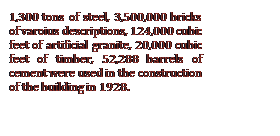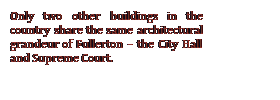
Singapore Story: Story of the Fullerton Building
“This building is, and will be for many years, one of the principal landmarks of Singapore,” said Governor Sir Hugh Clifford at the opening of Fullerton Building on June, 27 1928. (The Straits Times)
 He was right. Eighty five years later the Fullerton Building stands majestic and prominent on the city’s skyline. This grey Aberdine granite building with tall Doric columns has seen Singapore’s transition from a fishing village to the busiest ports in the world, and from a colony to a country. The story of Fullerton is interwoven with Singapore’s past, present and future.
He was right. Eighty five years later the Fullerton Building stands majestic and prominent on the city’s skyline. This grey Aberdine granite building with tall Doric columns has seen Singapore’s transition from a fishing village to the busiest ports in the world, and from a colony to a country. The story of Fullerton is interwoven with Singapore’s past, present and future.
The Fullerton Hotel as you see it today was once the Fullerton Building, named after Robert Fullerton, the first Governor of the Straits Settlements (1826-1829). The building was commissioned in 1919 as a part of the British colony’s centennial celebrations. Among all the festivities and lavish celebrations that reflected the optimism of the community, this was the most ambitious one. The Fullerton Building was to be the largest structure ever built in Singapore.
Major P. H. Keys of Keys & Dowdeswell, a Shanghai firm of architects won the project through an architectural design competition and gave the Fullerton Building its Neo- classical architectural grandeur. Foundations were laid in 1924 and after four years of hard labour and more that $ 4 millon spent, the grand government administration building stood 120 feet tall (yes, that is the height of the walls measured from the groud) on 41,100 square meters of land. The Fullerton Building became the symbol of modern Singapore- prominet on the skyline, pictured on postcards and recognised by ship captains and travellers.

 A newspaper report on the inauguration in The Straits Times described the building design representing a ‘...happy mean between beauty and utility, lightness and mass, and ornamentation and dignity.’ The Fullerton Building had fourteen elevators and was home mainly to the General Post Office, The Exchange, Singapore Club, Marine Department and the Import and Export Department. General Post Office was the anchor tenant and moved within two weeks of its opening. It occupied the lower two floors with postal halls, sorting rooms and offices. A basement connected to a thirty-five meter subway that ran under Fullerton Road to a pier. From here thousands of letters crossed the seas to bring and take back stories of people and countries. (If you visit the hotel today you will still find two red pillar post boxes, which came to Singapore in 1873 during the British
A newspaper report on the inauguration in The Straits Times described the building design representing a ‘...happy mean between beauty and utility, lightness and mass, and ornamentation and dignity.’ The Fullerton Building had fourteen elevators and was home mainly to the General Post Office, The Exchange, Singapore Club, Marine Department and the Import and Export Department. General Post Office was the anchor tenant and moved within two weeks of its opening. It occupied the lower two floors with postal halls, sorting rooms and offices. A basement connected to a thirty-five meter subway that ran under Fullerton Road to a pier. From here thousands of letters crossed the seas to bring and take back stories of people and countries. (If you visit the hotel today you will still find two red pillar post boxes, which came to Singapore in 1873 during the British
 colonial rule. Around five o’clock in the evening you may also see a postman dressed as postmen were in those years, come to clear the mail). The building was designed for natural ventilation before the age of air-conditioning. Four internal air-wells kept the building cool. It is said to be the largest and the last example of this kind of architecture in Singapore.
colonial rule. Around five o’clock in the evening you may also see a postman dressed as postmen were in those years, come to clear the mail). The building was designed for natural ventilation before the age of air-conditioning. Four internal air-wells kept the building cool. It is said to be the largest and the last example of this kind of architecture in Singapore.
The Singapore Club, patronized by the well heeled was on the upper floors. Patrons used the entrance that The Salon de Florere has today. With a lounge, reading room, library, card and billiard rooms, Singapore Club became the socializing and dining spot for high-ranking officials. The billiard room had six tables and a separate private billiard room could take two tables. (When you go upstairs to see where the billiard room was (used for parties and receptions now), do look at the ceiling. You will get a glimpse of the grandeur etched in the building’s history). The club bar was 200ft long. The dining hall faced Battery road and had the capacity of two hundred people. Accommodation for members was also available. In fact it was in these quarters that Governor Sir Shenton Thomas and Lady Thomas took refuge when the government house became uninhabitable due to bombardment during the Japanese occupation of Singapore. It was here, in their fourth story room that the British Governor was told of British military’s decision to surrender to the Japanese during World War II. (The room is now an exclusive lounge. When you go there do look at the barrel vaulted coffered ceiling- it is the only of its kind in Singapore).

In the last days of British surrender to Japan, the premises were used as a hospital for British soldiers with makeshift operating rooms. After the surrender, Fullerton Building became the headquarters of Japanese military administration in Singapore. (The Japanese occupied Singapore in 1942 until the British repossessed it in 1945 after the Japanese surrender).
Singapore’s transition from colonial status to nationhood took place at Fullerton Square, beside the Cavenagh Bridge. Political rallies between 1959 and 1988 were held here. Mr. Lee Kuan Yew stood on the podium and addressed thousands of people jostling for space. It was here, from the porticos and five foot ways of the Fullerton Building that crowds declared their support for independance.

The Fullerton Building, the centre of Singapore’s commercial, social and official life, saw Singapore grow and emerge as a financial centre. Singapore evolved and so did the Fullerton.
General Post Office moved out in 1996. The building was recognised as a historical landmark and placed under conservation in 1997.
Moving ahead with the times Fullerton was to be reborn as Fullerton Hotel. The challenge was to blend the magnificence and dignity of the original structure with the luxury and exuberance required by its new avatar. Extensive renovations were carried out and about $ 400 million were spent to convert the office building into a 400-room five-star luxury hotel. It was specified that the original exteriors and interiors be repaired and restored to its original condition as much as possible. The historic lighthouse that guided ships into the port was incorporated in a fine dining restaurant called The Lighthouse. Much like the old lighthouse, the new Lighthouse offers a view of the city line.
The Fullerton Hotel was officially launched at the stroke of midnight on January 1, 2001, and continues to participate in, and tell the success story of Singapore through the panoramic view it offers over Marina Bay and the ever-evolving city skyline.
